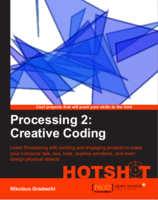processing sound visualizer explained
I have been asked to share the code of the sound visualizer I wrote in processing about a year ago, so I decided to write a blogpost explaining what I did
The program has two main parts - the autocorrelation function that creates the wiggly line and a glsl filter for the lens-distortion effect.
In the setup method of the procesing part I initialize minim - the sound library I use to access the sample data, load the glsl filter and initialize the sample playback
import ddf.minim.*;
PShader shift;
Minim minim;
AudioPlayer sample;
void setup() {
size(960, 540, P3D);
shift = loadShader("shift.glsl");
background(0);
frameRate(50);
smooth();
minim = new Minim(this);
sample = minim.loadFile("music.mp3", 1024);
sample.play();
}
in the draw method I simply create some curve vertices by looping throu the last 1024 samples of the sample and use the current value as the x-coordinate and the value of the sample after a slight delay as the y-coordinate of the sample. This technique ist sometimes used to evaluate the quality of a random number generator.
void draw() {
background(0);
stroke(128);
strokeWeight(1);
for ( int i=0; i<height/60; i++) {
line(0, i*60, width, i*60);
}
for ( int i=0; i<width/60; i++) {
line(i*60, 0, i*60, height);
}
translate(width/2, height/2);
scale(1, 2);
rotate(-PI/4);
strokeWeight(2);
stroke(255, 120);
noFill();
beginShape();
float f = 400;
float left[] = sample.left.toArray();
for ( int i =0; i<sample.bufferSize() -10; i++) {
float x1 = left[i];
float x2 = left[i+10];
curveVertex( (x1)*f, (x2)*f);
}
endShape();
filter(shift);
}
the glsl filter takes the color of a pixel and shifts it slightly dependend on the distance to the midpoint and the color.
uniform sampler2D texture;
uniform vec2 texOffset;
varying vec4 vertColor;
varying vec4 vertTexCoord;
void main(void) {
vec2 mid = vec2(0.5,0.5);
vec2 coord = (vertTexCoord.st - mid) * 0.9 + mid;
float d = pow(distance(coord, mid),2)*.1;
vec2 dir= normalize(coord - mid);
vec4 col1 = texture2D(texture, coord + dir*d);
float d2 = pow(distance(coord, mid),2)*.115;
vec4 col2 = texture2D(texture, coord + dir*d2);
vec4 c = vec4( col1.r, col2.g, col2.b, 1.0);
gl_FragColor = c;
}
See also:
processing sound visualizer
Phase Shift
Processing and Blender Sound Visualizer for Magical Dreams
Animation Node experiment - circular sound visualizer







hi! i was able to get your code running, and this was the result: https://www.youtube.com/watch?v=aRaw8txHe4Y
looking forward to adding on other effects from this library as well: https://www.cg.tuwien.ac.at/courses/projekte_old/vis/finished/CPramerdorfer/visualizers.html